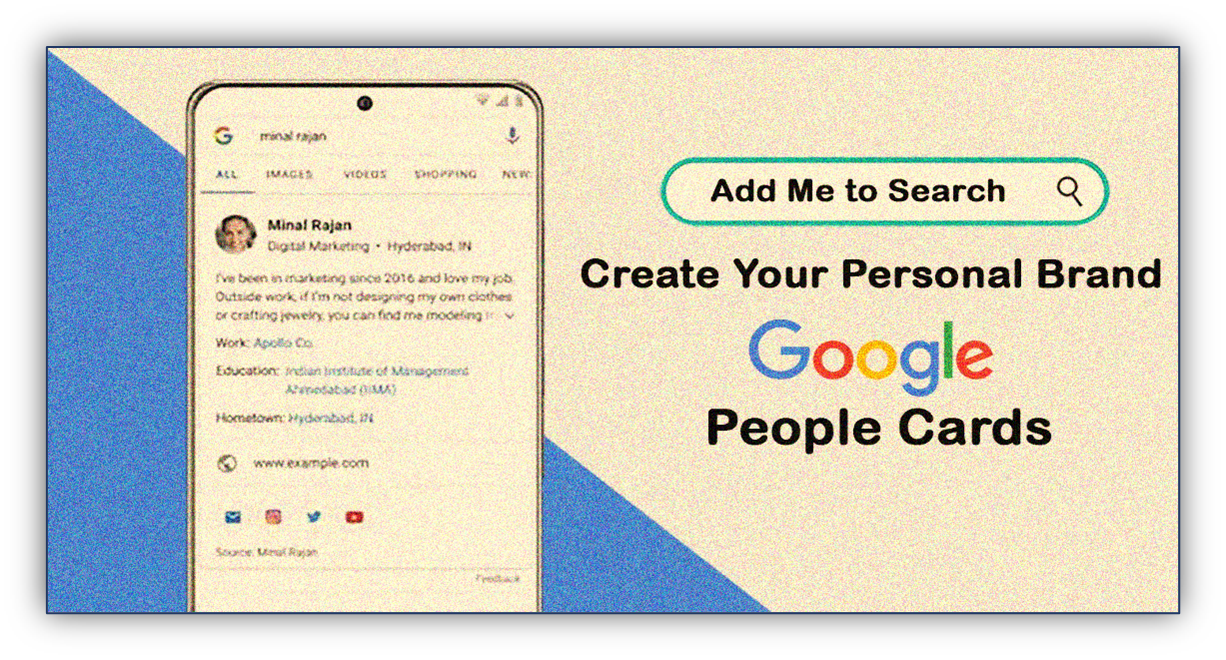- November 22, 2023
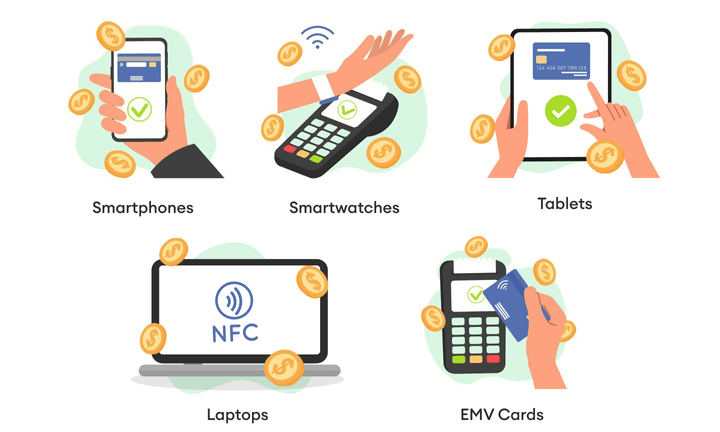
The rise of digital technology has drastically changed the mode of payment. People rely on debit cards, Visa/MasterCard cards, or mobile phone applications for quick and secure payment options. In the digital age, users are introduced to another digital mode of payment known as NFC. The technology became popular in the year, 2004, when famous brands, Nokia and Sony worked in partnership to form an NFC forum. In the same year, contactless payment was launched in the USA. In 2008, Visa, MasterCard, and American Express created contactless credit cards. As technology progressed, mobile app development created digital wallet solutions comprising Google Wallet and Android Pay NFC-enabled cards to initiate contactless payment through smartphones.
Today, NFC-enabled payment systems are well-recognized globally. According to Insider Intelligence, 48.2% of smartphone users in the year 2023-24 will execute their mobile payments with contactless cards. Global Payments Report, 2021 estimates that by 2024, digital wallet payment volume will reach 40.5%.
The process of NFC payment allows consumers to make payments with smartphones, Android devices, iPhones, laptops, tablets, and smartwatches. People no longer require credit or debit cards to make online payments. As the users tap their NFC-enabled smartphones, they can make fast and secure payments using contactless digital payment options.
Moreover, embracing contactless helps companies to make quick, effortless, and safe payments. Both small and large enterprises who are involved with online business are using this contactless payment processing option to meet day-to-day transactions. For instance, a range of businesses, including retailers, restaurants and online stores accept NFC payments. Businesses have streamlined their payment process by employing this contactless payment solution. Consequently, it helps reduce the risk of handling cash, generate high revenue, and monetize their NFC payment infrastructure. Thus, NFC payments have offered convenient options of payment for businesses to improve international transactions, and expand their customer base worldwide.
Mastering Contactless Payments: Fast, Hassle-Free Solutions for All!
NFC technology has a seamless payment system that connects two devices to communicate when they are nearby. The contactless payment system introduced in the early 2000s employed a specific RFID frequency (13.56MHz) for close-range communications. As NFC payment has expediently become popular and convenient for consumers and businesses, many companies use NFC identification cards to make contactless payments. It does not require any physical contact between a reader and a payment device. The users just need to hold up their mobile devices to pay the required amount. Both the reader and payment device must contain chips to facilitate the data exchange. The data exchange includes providing encrypted information such as face ID, fingerprint, or a passcode. Moreover, the users are required to provide authorization from the mobile device. Once the information is validated, the transaction information is transmitted into the business bank account automatically. The users insert a randomly generated one-time code that secures the transaction. Thus, biometric and multi-factor authentication is done, and the users can proceed with the transaction process.
Companies dealing with NFC mobile payments are required to follow a simple process. They have to choose a payment-processing company that offers NFC-enabled technology. Once connected with merchant services, the business should set up their merchant account with its bank or the processing company they are collaborating with. The next step involves installing an NFC reader-based POS solution that helps companies accept NFC payments. An NFC reader will automatically proceed with transactions into the company’s business bank account on the same day. For those exploring the world of digital assets, incorporating NFT development service into their business model can open up new and innovative possibilities within the evolving landscape of blockchain technology.
Different types of businesses accept NFC payments. They comprise retailers who manage online clothing stores, outfit dealers, and home goods stores. Street vendors, restaurants, and food-service businesses are also involved with multiple payments. Fitness and recreation services and other small and big enterprises operate their cash business using NFC payment mode.
NFC payment can be transmitted through numerous mobile devices. NFC mobile application development has created innovative applications that use encrypted and tokenized technologies. If you are using smartphones to make NFC payments, you are required to integrate various wallet apps into Android, iPhone, and other mobile devices. Digital Wallet apps including Apple Pay, Samsung Pay, and Google Pay have NFC features. Once users have access to these apps on their devices, they just need to grab the device within range and make payment instantly. NFC technology reduces queue time, enabling users to make convenient and quick digital payments. Customers who prefer online payment systems also use wearables including smartwatches, Apple Watch, and Google Wear OS to make NFC payments.
Tablets and laptops having in-built NFC features allow consumers to make digital payments. Laptops and other devices are connected to an NFC-enabled card that enables companies to receive quick instant payments. To further streamline the payment process, many companies use EMV Cards: Today, most online users have credit and debit cards with EMV chip that supports NFC. Contactless payment solutions offer vast possibilities to companies to make online payments. The payment technology is generally considered safe and convenient like mobile credit card processing. Hence, they benefit both businesses and customers with seamless payment solutions.
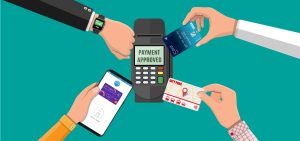
Unlock the simplicity, convenience, speed, and security of contactless payments!
Unlock the world of contactless payments, where simplicity, convenience, speed, and security converge. Say goodbye to fumbling for cash or swiping cards – just tap, scan, or wave your way to effortless transactions. Whether it’s with NFC, QR codes, or other emerging technologies, the future of payments is at your fingertips, making your financial interactions seamless and safe.
Benefits for Consumers
-
Convenient Payment Options
Whether consumers are using credit and debit card payments or getting involved with online payment, they always expect to have secure and convenient transactions. If you have to make multiple payments for different purposes, you must opt for the NFC payment system. While choosing an online transaction mode of payment, this contactless payment solution appears to be a more reliable, fast, simple, and appropriate payment option for consumers. The users have to install an NFC POS reader in their mobile device or wearables to make payments. There is no hassle of payment, just consumers are required to hold up their phones or their NFC cards to make instant payment. Unlike other transactions, where consumers have to wait for hours to get payment approved, NFC mobile payments follow an easy, intuitive, and quick payment process. For businesses looking to capitalize on the trend of wearables, integrating wearable app development services into their strategy can enhance the overall user experience and provide a seamless payment solution through wearable devices.
-
The Efficiency of NFC Payments
Customers who have to make consistent online payments look for a fast and efficient payment system. Using mobile wallets, consumers can process huge amounts to either buy groceries, online shopping, pay tuition fees, or travel by public transportation. NFC mobile payments through mobile apps, including UPI Payment App Development, are effective. Consumers are required to get connected to the payment processor. Ensure that the mobile device or gadget is equipped with radio frequency identification (RFID). Furthermore, it should be properly linked with the service provider’s account to transfer payment swiftly. NFC payments can be made via contactless cards and mobile wallets. Hence, NFC payment options are user-friendly and accessible to consumers.
-
Enable Seamless Secure Payments
The increasing trend of using digital payment solutions has encouraged many users to integrate their devices with digital payment that offers a secure and seamless payment experience. By adding contactless card or mobile wallet apps such as Apple Pay or Google Pay to their smartphone or wearable device, consumers can make rapid contactless payments. Safe transmission is made within 24 hours. If the transaction is small, it transfers the amount instantly. In case, big payments are made, it transferred to the business account the following day.
-
Contactless Travel Payment
NFC payment solutions have facilitated customers to have easy and contactless ticketing and payment options. A traveler can buy e-tickets using any mobile device or wearable or NFC-enabled cards. Consumers are required to tap the information tags inserted in the app. They can easily download the tickets and read the required information. Contactless payment appears to be durable and feasible for frequent travelers as they can pay their transit expenses instantly. If you are making a short-distance bus journey, you can smoothly tap your card or mobile wallet on your mobile to make a payment. Hence, NFC payment offers convenient and safe payment options to visitors.
Benefits for Businesses
-
Dynamic and progressive contactless payment option
The businesses that have embraced NFC payments indicate that they are forward-thinking companies that offer fast, resourceful, and convenient payment options for customers. The wireless financial transaction option allows businesses to make transactions through chip-enabled bank cards and digital wallet apps. NFC payments are vibrant and secure as users are not required to share billing information directly with the seller. Before payment, users are provided with a one-time transaction code that keeps transmitted data secured. The dynamic authentication technology generates a new code each time a chip card is used for payment. It helps prevent data breaches and hacking of business accounts.
-
NFC supports businesses in improving the consumer’s in-store experience
Companies can use NFC apps for asset tracking. The innovative payment option allows companies to know when the consumers leave the storage area, whether they have made online payments through NFC cards or mobile wallets. The NFC app secures all consumer data including the name, particulars, and personal contact details. Moreover, the online store also expounds the amount paid to make online purchases. To check the transparency and security of the asset and payment, the users can log in again to their accounts to check online receipts and balances. Having attached NFC tags at storage facilities allows companies to regularly check consumers’ status each time they make purchases. NFC improves customer service and develops business process control.
-
Cost-effective payment method
Offering tangible benefits to businesses, NFC lessens payment processing time. The users can make NFC payments using different devices and methods. NFC cards and cards and mobile wallets, streamline the payment process. Consumers can easily sign up for the account and make quick payments. Consequently, they gain faster checkout experiences. An economical contactless payment system minimizes cash handling while reducing the need to carry physical cards.
-
Security protections
NFC offers a high level of data encryption, connection, and data exchange. NFC has a highly efficient security system that makes data exchange secure. Businesses can protect data and make secure payments through tokenization of private and personally identifying data. The smartphone device allows users to provide authentication passwords and biometric security. The additional security feature prevents fraud filters and secures business transactions.
-
NFC technologies work without Wi-Fi or 3G
It is a significant advantage for small and medium businesses that lack internet facilities or have weak internet signals. Sometimes, users have to make urgent payments, and exchanging data without the internet makes online payment a hassle. Therefore, many small businesses do not invest in installing digital technologies, rather they use contactless payment options. For instance, small shops use POS terminals having built-in NFC functions as they mostly lack Wi-Fi facilities. They execute their businesses by deploying wireless technology that connects two NFC devices. Many hotels and restaurants also provide NFC payment options in case users have no Wi-Fi access or their 3G limit expires. NFC technology has grown versatile; it is open, steady, and accessible for all users. NFC technology is helpful for multiple business purposes. Either the company buys NFC tags or stickers and configure them with the consumer’s account and service providers. The other payment option is using appropriate NFC mobile wallet apps that help process quick and smart payments.
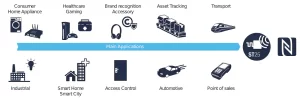
The Global Trends and Future Prospects of NFC Payments:
The environment of transactions is changing as a result of global trends and NFC payments’ potential. These technological developments have simplified payments, making contactless transactions more common and practical. The world is currently experiencing a change brought on by NFC technology, with the future of payments being defined by speed, security, and frictionless interactions. NFC payments are expected to become increasingly important as the world of digital banking develops.
1. The Role of NFC in the Internet of Things (IoT)
Approximately all modern smartphones have built-in NFC chips and Mobile wallet apps that ensure secure and easy payment options. NFC also facilitates users with quick payment if they lack internet access. For instance, mobile devices and wearables have built-in NFC tags. Whenever a user gets connected to a new device, they can use an NFC tag to automatically configure the device and make payments.
NFC increases IoT scalability as NFC can be feasibly used in areas with restricted security access or lack Wi-Fi. NFC enables people to use their smartphones, wristbands, and other gadgets to make contactless payments. NFC connects two separate IoT devices with minimal configuration. The system just requires wireless technology as the users have to keep the device close to the other device to process transactions. Moreover, joining the two devices through NFC provides easy network access and data sharing. The users no longer need to make data entries or require an internet connection, they just need to tap their NFC-enabled devices to make online payments. Consequently, NFC offers data security through different devices and networks.
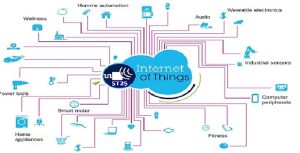
2. NFC Wearables and other Innovations Used for Payment
The contactless payment option benefits customers by making payments through different methods. The most popular procedure for making digital payments is using smartwatches, wristwatches, bracelets, rings, and other electronic devices. Before using the wearable device for payment, the users are required to associate the device with a payment method including a contactless card, a bank account, or a smartphone app. Once the device is connected, the users should wear it and install point-of-sale (POS) hardware to manage NFC payments. Wearable payment devices are incorporated with NFC technology. Wearable users can make payments without taking out their phone, card, or wallet. Thus, NFC facilitates both consumers and businesses in making convenient and accessible payment choices.

3. Future Trends and The Global Landscape of NFC Payments
-
Biometric payments
Biometric technology is one of the rising trends that offer seamless and secure contactless payment options to users. Customers who use biometric transactions do not require authentication methods like PINs and passwords. Instead, biometric payments follow the identification process comprising fingerprints, face, voice, and signatures to authenticate transactions. Moreover, consumers do not need to carry physical cards or cash to make quick transactions.
-
QR code payments
Another emerging digital payment option is QR codes. The users who employ this contactless payment do not need to keep credit / Master cards or cash to make transactions. The payment process is easy and convenient for the users. They need a smartphone camera to scan the code and make authentic and secure transactions. Since contactless payment has increasingly been used by consumers globally, QR code payments offer increased security by encrypting payment information and data. Being cost-effective, the users do not require any software to be installed. Therefore, this mode of payment is extensively used by small businesses to make secure and fast transactions.
-
Digital wallet
An advanced and convenient payment solution allows consumers to store multiple payment methods in one place. Consumers store their credit and debit cards, loyalty cards, and gift cards in one place. Moreover, users are ensured that payment information in their digital wallet is secured. Consumer data is encrypted and tokenized which decreases the risk of fraud and also protects data from unauthorized access.
Conclusion
Contactless payments have become popular and convenient for consumers and businesses as they offer a faster, safer, and easier way of payment. In the digital era, more people use numerous devices including smartphones, smartwatches, and other devices to pay for online transactions. The contactless payment option offers convenience, speed, and security of payment. Instead, of carrying cash or cards, the users have to scan their devices and transmit payment information. The users have to simply hold their smartphone and pay instantly. An exclusive feature of NFC mobile payments is the two-way encryption that ensures higher security such as face ID, fingerprint, or a passcode. The card information and a randomly generated one-time use code are inserted to ensure data transfer security and provide a seamless and consistent payment experience to users across different channels and platforms. NFC technologies provide more options and benefits for both consumers and businesses. It includes authentication, loyalty, rewards, and data analytics. Technology innovation in NFC has revolutionized the payment industry, ensuring the security and privacy of mobile and contactless payments.
- November 20, 2023
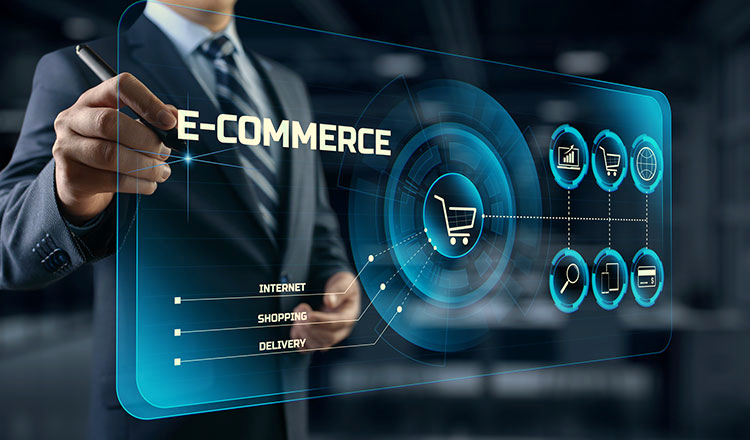
Whether you are managing an e-commerce business or using an e-commerce app on your smartphone or iPhone to search new brands, read product descriptions, check customer reviews about the brand, or learn about online payment systems, e-commerce apps offer consumers a feasible and convenient online shopping experience.
According to Accenture’s research, the usage of mobile e-commerce apps has extensively increased over the years. Consumer buying trends and patterns have considerably changed as most customers prefer using apps to make online purchases. Instead of standing in queues and facing payment hassle or visiting shops for surveying and making purchases, people now look for convenience and ease. In-app ordering and home delivery have increased. Statistics provided by Insider Intelligence indicate that 93.5% of global internet users make online buying and selling of products.
With a tap of a button, customers use apps to visit e-commerce sites. They browse various products including clothing, health or beauty items, food or drinks, or event tickets using Apple, Android, and iPhone. In the year 2023, e-commerce apps have maximized potential revenue, the expected revenue to be gained is $415.93 billion mark. Within a few years, e-commerce mobile app users have widely increased. Along with providing outstanding mobile shopping experiences, and flexible and easy payment options, the e-commerce mobile apps have boosted context-driven marketing and improved customer engagement.
If you desire to grow your online business, mobile e-commerce apps will help build a branded e-commerce store that increases brand awareness and promotion. As your online shopping cart becomes visible to potential customers, more people across the globe visit your e-store employing digital wallets, or social media shopping.
Mobile e-commerce apps give the best e-commerce experience to customers and businesses
E-commerce apps for consumers: Where convenience meets affordability
E-commerce app development companies have introduced innovative apps that have changed sellers’ buying and selling behavior. It has made it easier for consumers to make online purchases from in-store. Consequently, e-commerce apps have helped develop the convenience of online shopping. Having gained online shopping experience allows consumers can buy anything they desire comfortably from their home or workplace. Moreover, they can shop with ease, as they can navigate the app, and search for products by visiting different web pages. While browsing different sites, consumers can analyze and compare numerous brands and choose what suits them. They can download products from different sellers in one place and can select appropriate colors, and sizes. Furthermore, visiting different online shops enables people to compare sellers’ prices, exclusive sales, and discounts and learn about product quality. E-commerce customers can come up with more informed and consistent buying decisions and make payments through easy and reliable methods. Hence, using numerous e-commerce apps offers a pleasant, and stress-free shopping experience. This experience has been further enriched by exploring headless ecommerce platforms, enhancing flexibility and empowering users to access various sellers, compare products, and make informed purchasing decisions effortlessly.
Endless Possibilities for Business with E-commerce
Let’s suppose, you are managing a physical store, your sales might be less due to geographical and linguistic barriers. However, running online e-commerce businesses, be it B2B marketplaces or B2C ones, will help increase your business and customer outreach. Customers from all over the world visit your web pages and social media pages to review the product. Using different e-commerce apps allows businesses to promote brand awareness by demonstrating their products and services on their product landing pages. The apps help companies create an online catalog of products, enabling mobile users to view the catalog from their mobile devices. Customers can flexibly view different categories of products regardless of distance, time zone, or language. Consequently, customers can better understand the product and its features.
From startups to small-sized businesses and established brands, businesses, traders and retailers have benefitted from their physical and online stores. The influx of new technology in the e-commerce app industry has boosted B2C and B2B businesses, online social media marketing, email marketing, and search engine marketing. The apps are convenient, and user-friendly as consumers can navigate the interface and different sections easily. Being quick and efficient, the app enables people to get access to the products they require. As more mobile commerce users are increasing, app developers have launched high-quality apps that have helped in providing updated and authentic product descriptions and pricing, location tracking. Outstanding and well-structured e-commerce apps have robust features that help improve personalized shopping experience, offering feasible payment methods to transfer funds online.
Usability Testing Optimizes the mobile e-commerce experience for iOS and Android Users
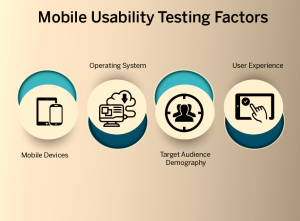
Usability testing allows users to interact with the product and make necessary changes to enhance the quality of the product before it goes for development.The testing procedures conducted by a software testing company in India are significant as they evaluate the app’s performance, and how the product design works. Moreover, testing also benefits companies in knowing the existing and changing customers’ choices and trends. Through product testing and analysis, developers can identify problems in the apps. They fix both major and minor flaws before the app is coded and deployed.
Conducting proper and effective usability testing allow product managers to understand the nature and requirement of the app. A comprehensive market survey helps companies to create custom mobile e-commerce applications with robust functions and features. The app allows product managers, designers, and developers to identify how the app is beneficial for the users and adjust features based on the user’s needs. With usability testing, businesses come to know the app’s success in the marketplace. They determine the value and utility of the app in the consumer market. Consequently, usability testing helps companies know whether the app is complex or can be flexibly used by customers. The testing process helps create practical and functional products that bring artistic and creative impact to the users. The app’s final testing and designing increase users’ experience with the app, and build strong brand loyalty and brand visibility in the e-commerce industry.
Types of Testing required for e-commerce Apps
1. Functional testing of the app
Let’s suppose, you have planned to launch a new brand. In the initial stage, you will get involved with functional app testing that defines the essential features required by an e-commerce application. For instance, you require additional features of adding products to the shopping cart and a valid promo code for your purchase. Furthermore executing functional testing helps improve the engineering workflow of the app and enhance product design. During this phase, designers and developers carry out extensive product research, prototyping, and testing to develop product design. Another crucial aspect of functional testing is to identify malfunctions or bugs that may ruin the quality of the product and may not attract extensive customers. Robust testing also analyzes the groundwork to develop a well-function app. The features that require testing include the login system of the app, and how users search the result page and place order details. Functional testing improves shopping cart features, deals, and promo codes. Tracking orders and a reliable payment system improve customer experience with the app.
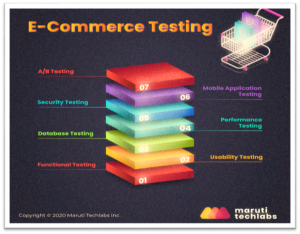
2. Usability and Performance Testing
A black box testing technique that examines the ineffectiveness of the user interface of the app. It includes complex navigation, poor screen loading, and the speed and scalability of the app. The testing procedures also analyze the significant events that allow the app to reach its peak performance, bring a huge inflow of traffic, and lead to high e-commerce sales. Comprehensive usability testing improves a customer’s online and physical shopping experience. It evaluates the quality of app designs, and the performance of CTA buttons moreover, testing allows app companies to handle competition, avoid cart abandonment, and help drive more sales. Underperformance testing, e-commerce app developers conduct load, volume, speed, and scalability testing.
3. Security Testing
To avoid the threat of fraud, and security breaches allow developers to execute security testing of e-commerce applications. Through security testing, the app developers get involved with a variety of testing processes such as penetration testing, security auditing, and security scanning of the app to prevent ethical hacking and data theft.
Automated Testing Tools and Frameworks Benefitting QA Teams

E-commerce app development services also initiate test automation frameworks that thoroughly check coding standards, test data management techniques, and data storage capacity. The test ensures that the programming codes and scripts can be reused at any given time in the future. Therefore, the developers protect the valuable data and scripts and rearrange the codes to increase app productivity. Moreover, the automated tests decrease maintenance costs and offer a higher return on investment (ROI) for QA teams to optimize their testing processes.
The app developers conduct different categories of automation framework tests that include data-driven testing frameworks. A series of tests takes place before finally launching the app in the market. Consequently, the automated test allows developers to alter the test data and codes to add innovation to the app. The keyword-driven testing framework benefits designers, allowing them to bring out essential test data from external sources. Developers maintain the set of codes or keywords to bring relevant changes in the script and improve the application functions.
Developers carry out a hybrid testing framework. The testing framework having additional testing features helps improve app productivity. An important testing framework known as a module-based testing framework requires designers to create different scripts for every module. Once created, they join the modules to generate the best results from the automation test. Hence, the modules improve the product design process increase test efficiency, less maintenance costs, and ensure maximum app output and effective test coverage.
Popular Automated Testing Tools and Frameworks for E-commerce App Testing

1. Selenium
The significant testing framework comprising different programming languages such as Java, Python, Perl, and PHP is used to write test scripts. An open-source test automation having cross-browser and cross-platform functionality helps in the testing of mobile apps. Android developers and QA perform Selenium testing to ensure that all websites function smoothly and are easily navigated by Android users. Selenium tests can be easily run on all mobile devices by establishing a secure connection between the device and the Browser Stack cloud. Moreover, the testing session on devices also follows factory settings. When the test session is complete, the devices are restored to their original settings, ensuring secure storage of data. Privacy and security of documentation include personal data about the user, the account information, username, logins, password, codes, or keywords.
2. Appium
A flexible and reliable cross-platform testing framework allows designers and testers to create test scripts against multiple platforms such as iOS and Android. Developers use open-source automation frameworks that provide necessary information about different mobile applications functioning in the mobile industry. Consequently, the significant information provided assists developers in creating high-performing and compatible apps that resonate with customers changing trends and choices. The QA team can use automated app testing on different platforms including Android, iOS, and iPhone. App automation testing benefits designers by offering the flexibility to write test code in different languages, the reusability of the same code can be used for different devices such as iOS, and Android. It saves their time and effort. Cross-platform compatibility offers fast and reliable testing methods that ensure app scalability and also increase the speed of mobile application testing.
3. JUnit
A popular Java application testing framework allows developers to create automated tests to ensure that their code works perfectly. The testing app provides interpretations to developers to test the code. Furthermore, developers compare past and expected results that allow them to improve app productivity, fix bugs, and ensure that code operates efficiently. JUnit integrated with other development tools provides a unified testing experience to developers, enabling them to create a more reliable and compatible app for the users. Thus, JUnit escalates the mobile app’s functionality and increases user experience with the app.
4. Cucumber
Cucumber is used for mobile testing but it requires to be integrated with other mobile automation frameworks such as Appium. Like other automation testing, Cucumber also involves cross-platform app functionalities. Designers can write acceptance tests for different mobile platforms including Android and iPhone. Cucumber tests can be easily changed as engineers can reuse the code in the tests. As codes are written in a natural language such as Scala, Groovy, Net, PHP, and Python, the codes are less likely to break when developers alter the programming code. Consequently, the testing framework and, functional tests boost the application’s functionality and ensure that different parts of an application are working as expected.
Marketing your E-commerce App through Various Social Media Channels
1. Email Marketing allows e-commerce mobile apps to reach a vast audience
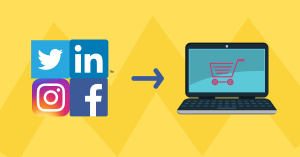
Email marketing is a perfect tool for targeted marketing in e-commerce. Email marketing campaigns allow e-commerce marketers to get connected with targeted customers. The email list including customer data helps create targeted e-commerce campaigns that are aligned with audience choice and preferences. The campaigns comprise generating email newsletters, brochures, promotional codes, and discounts help customers to engage with the brand meaningfully. Moreover, sending personalized messages to customers helps e-commerce businesses drive more traffic to their websites and bring high revenue. Email marketing is the most compelling strategy for businesses to reach their customers, improve brand recognition, and increase sales.
2. Search Engine Optimization (SEO)
Using E-commerce SEO allow business to generate more organic traffic on their e-commerce online store. Consumers search for the brand on Google by using strong e-commerce keywords, Meta descriptions, taglines, and hashtags. High-value search terms appear on the blog posts and marketing content makes it easier for consumers to search the product. High commercial keywords related to e-commerce stores to help boost search engine results, and bring more conversions and leads.
3. Social Media Marketing
Social media marketing campaigns on Facebook, Instagram, Pinterest, YouTube, TikTok, and Twitter boost e-commerce sites. Social media channels display the most attractive content that tempt users to buy the product. Blogs, interactive product videos, images, and social media posts entice the audience to visit the social media page. E-commerce marketers also generate highly appealing posts, and comments and share them on various platforms. As more consumers visit the social media pages, they also leave constructive reviews that attract new users to the product. Additionally, e-commerce apps also develop engaging reviews about online stores. The apps connected with social media channels allow prospective customers to explore products and their features on social media pages. Thus, social media marketing helps drive traffic to the e-commerce store and maximizes user engagement.
Conclusion
In today’s changing marketing paradigm, mobile e-commerce apps have played an eminent part in engaging customers with their brands. As many users browse websites to view the products, it helps create brand awareness. A vast audience visits e-commerce stores to explore the unique features of the brand or buy the products or services. The apps offer a pleasant and exciting shopping experience as consumers get fast and robust access to online shopping stores. All you have to do is sit in your apartment and navigate the colorful and eye-catching interface and other sections of the apps. The specialized e-commerce mobile apps offer extensive product information such as product variety, size, weight, color, material, warranty, and discounts. Moreover, the flexibility of making payments further boosts client trust and satisfaction with the company’s brand. The e-commerce apps benefit companies in growing their e-commerce retail business and developing business models and marketing strategies. Innovations in e-commerce apps have helped big corporate firms to develop their e-business and e-commerce infrastructure in the global market.
- November 17, 2023

Mobile apps have been crucial to the industry’s extraordinary progress in recent years, which has been seen in Dubai’s healthcare sector. Technology improvements and the widespread use of smartphones have sparked the creation of creative mobile applications that address numerous facets of healthcare, improving its efficiency and accessibility for both patients and healthcare providers. The delivery, administration, and accessibility of healthcare have all changed as a result of these apps, making the future of mobile apps in the healthcare industry quite promising.
Advantages of Mobile App Development in the Healthcare Industry
The improvement of patient care and engagement is one of the main benefits of mobile apps in healthcare. With just a few clicks on their smartphones patients can now access healthcare services, medical records and health related information. With the ability to book visits and receive individualized health suggestions, monitor their advancement towards wellness objectives, mobile apps empower patients to take a more proactive part in managing their health. These apps have greatly enhanced patient satisfaction and health outcomes by encouraging ongoing direct communication between patients and healthcare professionals.

1. Streamlining Administrative Processes for Healthcare Providers
Healthcare mobile apps have streamlined administrative processes for healthcare providers, freeing up valuable time and resources that can be redirected towards patient care. Advanced appointment scheduling systems and automated reminders minimize no-shows, optimizing healthcare providers’ schedules and ensuring maximum productivity. Additionally, electronic health record (EHR) management within mobile apps has enabled healthcare professionals to access patient information seamlessly, leading to more informed decision-making and coordinated care.
2. Improving Communication and Collaboration among Healthcare Teams
To provide high-quality healthcare, effective communication and collaboration are crucial. Secure texting and real-time notifications are made possible by mobile apps created specifically for healthcare environments, facilitating smooth communication between medical professionals. Shared calendars and scheduling tools ensure effective resource allocation and efficient team coordination, contributing to faster response times and improved patient care outcomes.
3. Ensuring Data Security and Privacy in Healthcare Mobile Apps
As the healthcare industry embraces digital transformation, ensuring data security and privacy is of paramount importance. Healthcare mobile apps adhere to strict data protection regulations and utilize robust encryption and authentication measures to safeguard sensitive patient information. By maintaining the confidentiality of medical records and other personal data, these apps instill trust in patients, encouraging them to engage more actively in their healthcare journey.
Advanced Patient Care Features in Healthcare Mobile Apps
In response to the diverse needs of patients and to improve healthcare outcomes healthcare mobile apps offer advanced patient care features. These functionalities empower patients to monitor their health regularly receive medication reminders for adherence access virtual consultations for remote healthcare services and access a wealth of health education resources. By incorporating such features, mobile apps play a crucial role in promoting proactive healthcare and better patient engagement.
1. Health Monitoring and Tracking for Better Healthcare Outcomes
Healthcare mobile apps integrate health monitoring and tracking features, empowering patients to monitor their vital signs and health parameters regularly. Metrics like heart rate, blood pressure, glucose levels and physical activity can all be tracked with these apps. After the data has been gathered it has been analyzed to produce useful insights that assist patients and healthcare professionals in making decisions and identifying potential health issues early on resulting in more efficient and customized treatment programs.
2. Medication Reminders and Adherence Support
Non-adherence to prescribed medications is a common challenge in healthcare, leading to treatment inefficiencies and suboptimal health outcomes. Mobile apps address this issue by offering timely medication reminders and adherence support. Patients can receive personalized notifications reminding them to take their medications as prescribed, and healthcare providers can monitor adherence remotely. This feature fosters medication compliance, improving the overall efficacy of treatment plans.
3. Telemedicine and Virtual Consultations for Remote Healthcare Services
In terms of providing healthcare remotely, telemedicine has changed the game. Mobile health applications for patients make it possible for them to consult with doctors and specialists from the comfort of their homes through the integration of telemedicine and virtual consultation capabilities. This not only benefits patients in remote areas but also facilitates continuity of care for individuals with mobility constraints. Telemedicine ensures timely access to medical expertise, reducing the need for physical visits and easing the burden on healthcare facilities.
4. Health Education and Information for Empowered Patients
Promoting proactive healthcare necessitates arming patients with health knowledge and empowerment. Healthcare mobile applications provide a multitude of instructional resources for a variety of health issues, including articles, videos, infographics, and interactive tools. Patients have access to useful information on disease management, disease prevention, treatment alternatives, and healthy lifestyle options. These apps inspire people to take charge of their well-being and make educated health decisions by encouraging health literacy and patient empowerment.
Streamlining Administrative Tasks with Healthcare Mobile Apps
Mobile apps have simplified the appointment scheduling process, allowing patients to book appointments with just a few taps on their smartphones. Automated reminders ensure patients do not miss appointments, reducing no-show rates and optimizing healthcare providers’ schedules.
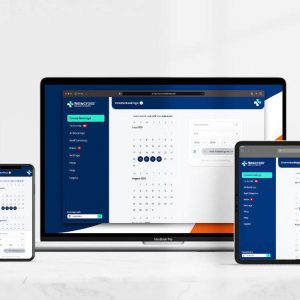
Electronic Health Records (EHR) Management for Efficient Healthcare Delivery
Transitioning from traditional paper-based records to electronic health records (EHR) has revolutionized healthcare delivery. Mobile apps enable seamless EHR management, providing instant access to patient information while maintaining data accuracy and privacy.
Billing and Payment Simplification for Healthcare Providers
Mobile apps have introduced user-friendly billing and payment systems, simplifying the billing process for both patients and healthcare providers. Patients can conveniently make payments through the app, reducing administrative burden and improving overall revenue cycle management.
Enhancing Communication and Collaboration in Healthcare Settings
Effective communication among healthcare professionals is essential to deliver coordinated and timely care. Mobile apps with secure messaging and real-time notification features facilitate instant communication between doctors, nurses, and support staff, enhancing teamwork and patient care.
Shared Calendars and Scheduling for Effective Resource Allocation
Mobile apps provide shared calendars and scheduling tools that optimize resource allocation in healthcare settings. Hospital departments and clinics can efficiently manage staff schedules, ensuring optimal coverage and maximizing productivity.
File Sharing and Collaborative Tools to Facilitate Teamwork
Collaboration is at the heart of quality healthcare. Mobile apps equipped with file sharing and collaborative tools enable healthcare teams to exchange critical patient information, diagnostic reports, and treatment plans seamlessly.
Key Features of Healthcare Mobile Apps for Dubai
Healthcare mobile apps in Dubai offer electronic medical records (EMR) access to patients, enabling them to stay informed about their health history and treatment plans. This empowers patients to actively participate in their healthcare decisions.
1. Appointment Booking and Reminders for Improved Patient Engagement
The convenience of booking appointments through mobile apps enhances patient engagement and encourages regular healthcare visits. Automated reminders further reinforce appointment adherence, contributing to better patient outcomes.
2. Medication Tracking and Reminders to Promote Adherence
Mobile apps with medication tracking features help patients manage their medication regimen effectively. Timely reminders and alerts ensure patients take their medications as prescribed, resulting in improved treatment outcomes.
3. Telemedicine and Virtual Consultations for Remote Healthcare Services
Telemedicine has gained popularity in Dubai due to its ability to provide healthcare services remotely. Healthcare mobile apps development in Dubai facilitate virtual consultations, bringing medical expertise to patients’ doorsteps.
4. Health and Wellness Monitoring for Better Lifestyle Choices
Dubai’s healthcare mobile apps incorporate health and wellness monitoring features that track fitness activities, nutrition, and overall well-being. These features empower users to make healthier lifestyle choices.
5. Health Education and Information to Empower Patients
Knowledge is empowering. Healthcare apps in Dubai offer comprehensive health education resources to empower patients with information about preventive care, treatment options, and disease management.
Future Trends in Dubai’s Healthcare Mobile App Development
The future of healthcare is being driven by machine learning (ML) and artificial intelligence (AI). Huge volumes of medical data are analyzed by mobile apps with AI-driven algorithms in order to forecast illness patterns, suggest personalized treatments, and boost diagnostic precision.
1. Wearable Integration for Real-time Health Monitoring and Data Collection
Wearable devices are becoming increasingly popular for health monitoring. Dubai’s healthcare with wearable mobile apps are integrating to collect real-time health data, providing a comprehensive view of patients’ health statuses.
2. The Internet of Medical Things (IoMT) for Remote Patient Monitoring
The Internet of Medical Things (IoMT) connects medical devices and systems to facilitate remote patient monitoring. Healthcare mobile apps leverage IoMT technology to monitor patients’ health conditions in real-time, enhancing remote healthcare services.
3. Virtual Reality (VR) and Augmented Reality (AR) for Enhanced Medical Training
Medical education and training are changing as a result of virtual reality (VR) and augmented reality (AR) technologies. Mobile applications for the healthcare industry give medical personnel immersive training opportunities that improve their knowledge and abilities.
4. Voice Recognition and Natural Language Processing for User Accessibility
Voice recognition and natural language processing technologies improve user accessibility in healthcare apps. Patients can interact with apps using voice commands, making the user experience more intuitive and inclusive.
Conclusion
The future of mobile apps in Dubai‘s healthcare sector holds immense promise. These apps have already transformed patient care, streamlined administrative processes, and facilitated seamless communication among healthcare teams. With the continuous integration of advanced technologies like AI, wearables, IoMT, VR, and voice recognition, Dubai’s healthcare mobile apps will continue to elevate the standard of healthcare delivery and patient experience.
- November 13, 2023

If you are managing a startup firm, you might have faced organizational data security issues such as unauthorized access, exposure of data to other networks, illegal modification of the network system, or stealing significant information stored on company databases, computers, or VPS servers. Today, both startup and established organizations are encountering two big challenges. Privacy challenge of protecting organizational data, and cyberattacks. Data breaches and cybercrime risks are usually caused by outer cyber attackers or insider hackers who intentionally take advantage of the security system. Having illegitimate access to data sources, the hackers misuse legitimate credentials and steal or manipulate the company’s data. Consequently, malicious insiders expose sensitive information to other network systems or users. The serious issue of data breach damages a business’s reputation in the market.
The article helps readers know about the importance of data security and the technical aspects that help protect data. Companies will get valuable information regarding preventing data breaches and cyberattacks. For instance, businesses learn about precautions that help them avoid unauthorized access to sensitive data and implement robust security and response plans to monitor data activity.
Knowing about Data Security Management
Whether you running a medium-sized enterprise or an established organization, understanding data security issues is significant in safeguarding a company’s confidential data through various processes such as data masking, encryption, and anonymization of sensitive information. Stealing or damaging the company data has caused different challenges to companies including financial loss, protect the identity and privacy of data, ownership of data subjects, compliance violation, and reputational damage. Consequently, data breaches also diminish brand image and customer trust. It may cause billions of dollars in loss to the company as they fail to retain their potential customers and partnerships with businesses and stakeholders.
From performing business operations to securing a computer network, sustaining the privacy of data, and disaster recovery, data security has different functions.
Best Practices for Data Security and Protection
1. Powerful access controls
According to this data security principle, companies provide limited access to users regarding getting access to confidential systems and data. All security devices including computers and servers are protected with obligatory login entries, and passwords that can only be used by authorized personnel. An expert team like Brightlab provides security codes to users or any programmer to get the required information.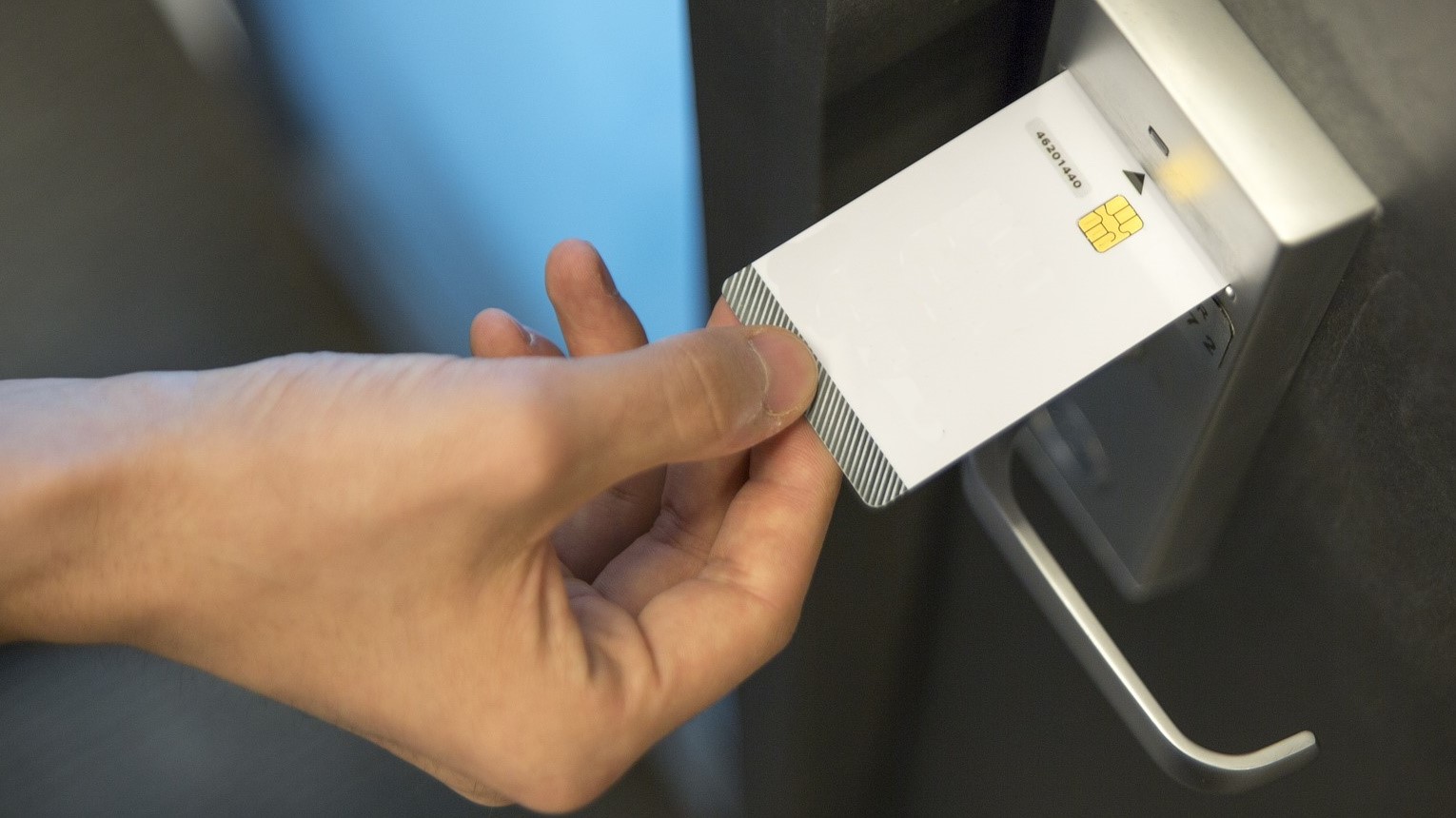
2. Strong Password Policies
Companies can protect their security systems including computer systems, networking, data, and information system from unauthorized access, theft, and damage by setting strong passwords in their security systems. Having a secret number gives identification to the corporate networks. Moreover, fixing passwords in computers, in the cloud, emails, and other digital communication systems will not allow criminals to get unauthorized access to the security systems.
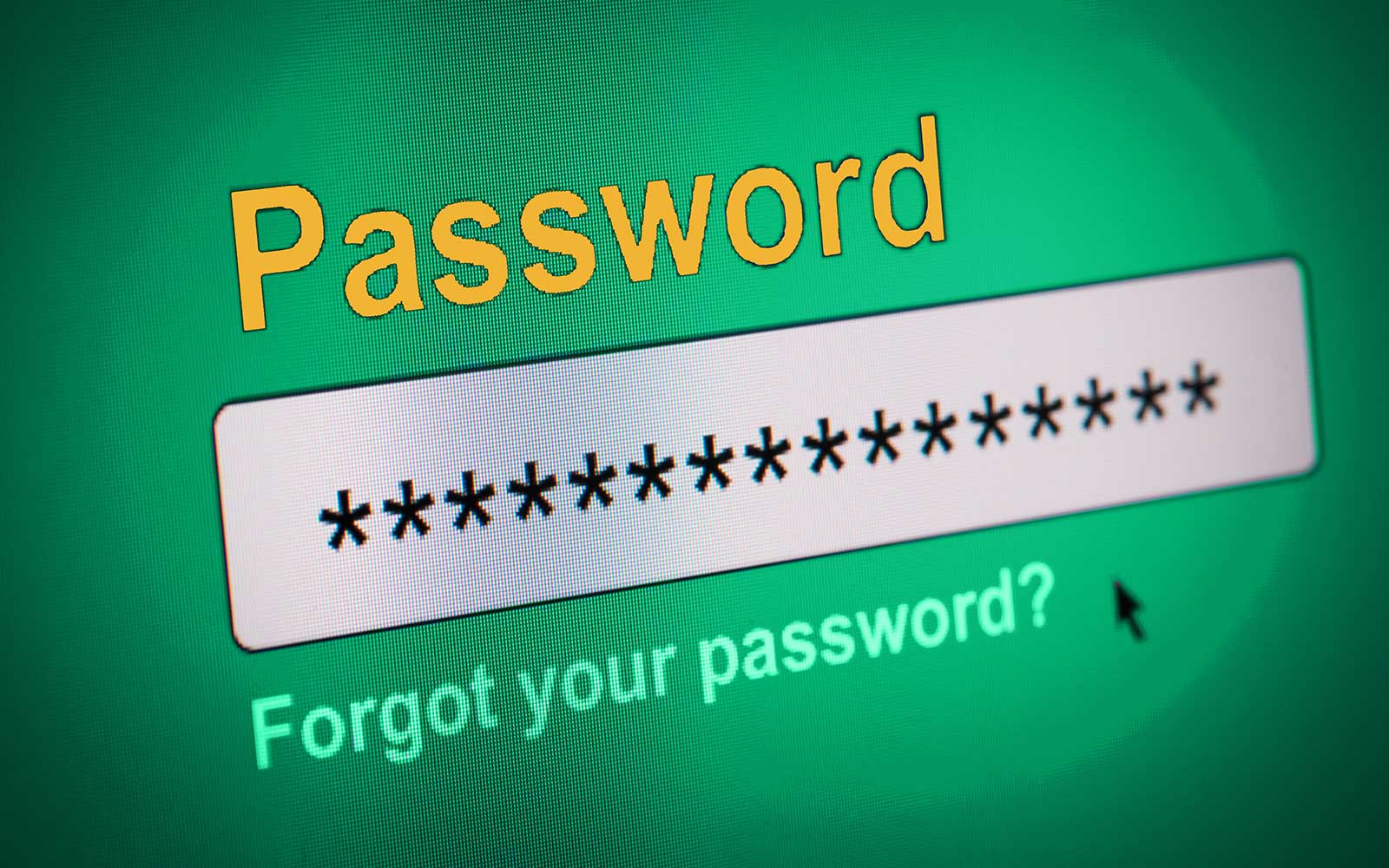
3. File systems help in securing data
Another important method to store unorganized data is to employ a file system. A compact file having different sections, separate the files and data into portions and give each unit a name or put a label. The filing system helps users to identify the file and gain access to the information required.
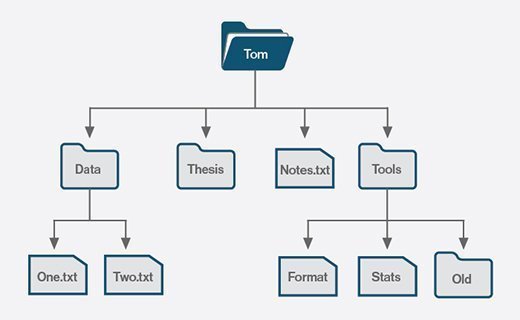
4. Operational security manages and safeguards confidential data
The function of operational security demonstrates the processes for handling and protecting data assets. Applying traceability, companies conduct monitoring, alerting, and auditing of significant information. The consent users have networking access that helps them know the local place where data is stored. Moreover, it also explains how users can have access to confidential resources and information.

5. Data availability
Expert users get access to systems and networks that help companies avoid security configuration errors. Security standards ensure crafting safety configurations to make backups of important data. Furthermore, it also prevents data breaches and compliance violations.
6. Disaster recovery and business stability
The function outlines how an organization responds to a cyber-security incident to prevent the stealing of data. Disaster recovery help companies reestablish their business operations and gain the same operating capacity as before the disaster. To let businesses thrive again, companies have adopted robust security systems and resources. Android app development services allow companies to employ different apps and technologies that protect security systems, servers, and assets. They ensure secure backup of data and fulfill restoration needs. Various security apps operating on mobile devices keep the device free of threats and ensure the reliability and privacy of data. Additionally, the app also classifies data and specifies different encryption levels for each data. Hence, data encryption ensures that the information is encoded before it is accessed by a user.
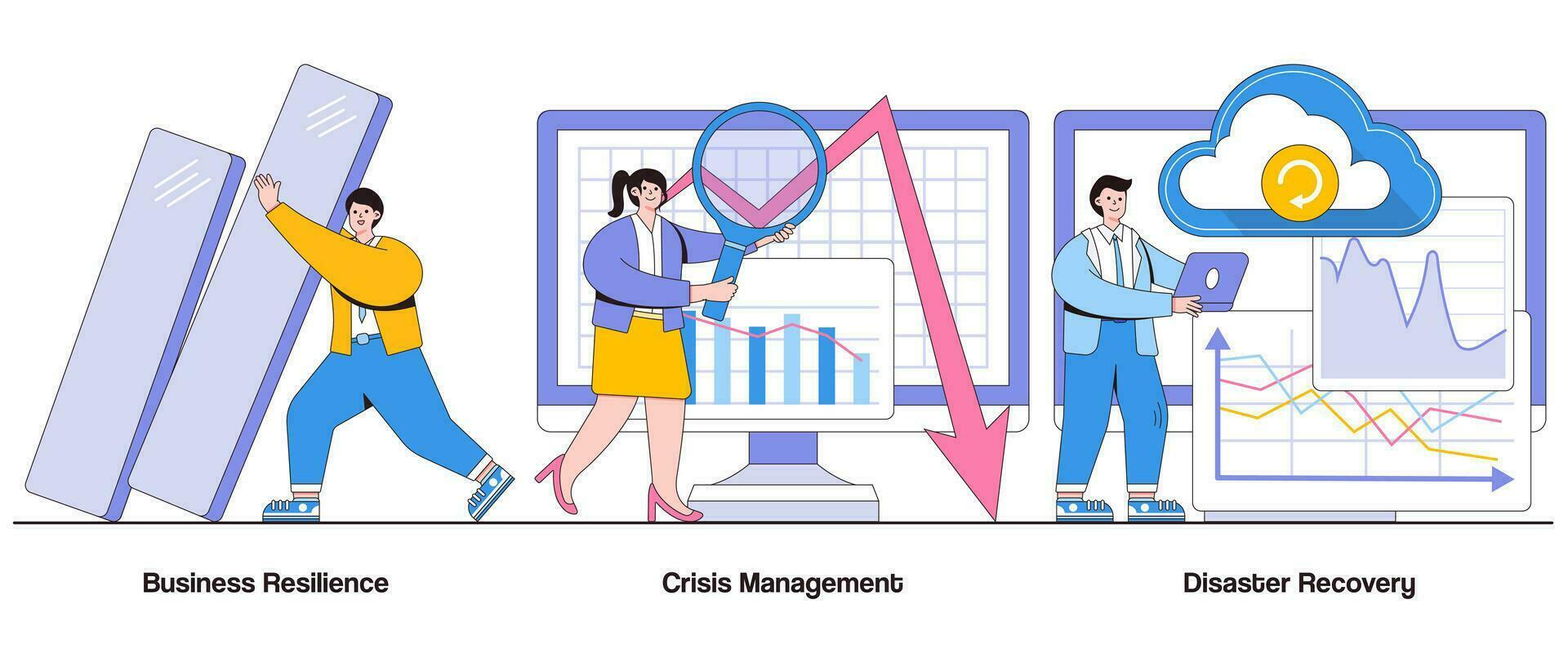
Understanding the Fraud Threats
Companies that are engaged in online business face fraud and scam cases in varying forms. Numerous types of fraud have been observed in corporate firms such as credit card fraud, stealing credentials and personal data. By demonstrating fake information, the fraudulent create a forged account, and they use linked accounts to exploit the users. Mismanaging funds is another business fraud that is widely seen in companies. This kind of fraud has become common in most companies. Employees and business owners exploit company funds to get offerings or special favors.
In most companies, employees do payroll fraud. They ask for advance payments with no intention to repay. Corrupt workers simply lie about their working hours and other details and manipulate the management. Return fraud is another deceitful activity. It happens if a customer buys a product, uses it, and then returns it to the company with the statement that the product has a manufacturing defect. Or in many cases, the product may be stolen or unavailable. The dealer instead of stating the fact makes excuses and earn high profit by delivering the wrong item to customers.
Dubious and unscrupulous behavior comes under fraud cases that are detected through technological tools and procedures. To prevent the theft of money, information, and assets, companies have come up with robust strategies to prevent fraudulent cases before it hampers business reputation in the market.
Fraud detection and prevention Strategies
Companies identify different kinds of fraud threats by employing different methods. Fraud analysts get to engage with manual processes to detect fraud. They employ different techniques to spot discrepancies in a document. For instance, the experts scrutinize manual documents to analyze the text style, alignment, spacing, and color to identify real and fake personal information. Moreover, companies use AI and machine learning technology to prevent fraud. Mobile application development assists companies with installing apps that work around the clock.
Using effective mobile forms app helps mobile application development companies to transfer their data from one server to another securely. Moreover, security apps performed efficiently as they keep the organization informed if they detect any illegal activity. The apps integrated with machine learning consistently monitor organization data, funds, and assets. It allows businesses to use probability models to detect false data and other suspicious activities. AI techniques help in monitoring the growing fraud threats, allowing companies to stay alert regarding new threats and provide prompt solutions to deal with upcoming fraud events.
Understanding Cyber Threats
The next part of the article provides knowledge of cyber threats and types of cyber threats. Readers come to know about various forms of Cyber attacks such as Malware, Phishing, Ransomware, and Denial of Service Attacks (DDoS). Knowing about these cybercrimes helps users to protect their data from fraudulent attacks.
Let’s begin by knowing what cyber security threat is and how business can protect their data from these cyber-attacks!
In recent years cyber security threats have largely increased in organizations. The hackers take advantage of security loopholes and vulnerabilities in security systems that provide illegal access to data, and confidential information. Consequently, cyber threats emerge from corporate spies, hacktivists, or criminal organizations that use computer networks and various technologies to get involved with malicious and illegal activities.
Some common cybercrimes include:
- Scammers use Phishing and Scam
Cyber attackers target users or organizations by sending false messages and emails to get complex company data. They use this malicious software to send scam emails or text messages to steal passwords, account numbers, or social security numbers. The scammers trick users by sending unexpected emails or text messages such as suspicious activity of signing in from their account. The cybercriminals assure the users that since the account has technical issues, they should contact the organization and provide personal or financial information. Scammer’s fake emails and messages may make companies lose their confidential data and suffer reputational damage.
- Malware software
Malicious software, Malware comprises various components that help attackers get access to the company’s network or servers to obtain sensitive information. For instance, by using Spyware, criminals track the company’s ongoing activities. They steal personal information, such as account passwords and credit card numbers, and transmit confidential data easily from hard drives.
Ransomware is malware that rejects a user or organization’s access to files on their computer. The convicts demand a ransom payment to get the decryption key. As the organizations get influenced by their tricks, they get the economical methods to regain access to significant files.
Since backdoor circumvents deny normal authentication procedures to access a system, cybercriminals get remote access to resources within an application. Culprits identify their targets by using scanners to locate the required websites. Then they reach underlying serves and databases to remotely access the security system. Moreover, the lawbreakers also get access to issue system commands to involve data theft and website hijacking.
- Internet Fraud
Criminals get involved with different forms of Internet fraud. For instance, cybercrimes include banking fraud and data theft. Cyberstalking refers to sending destructive and humiliating content about an individual online. The offensive content causes embarrassment and damages the users’ reputations.
- Distributed denial-of-service (DDoS)
The attackers use crucial secure networks and servers to occupy a company’s website. Using (DDoS, the criminals overload servers, and slow down the website speed and performance. The hackers make the website appear temporarily offline. Consequently, it brings the company’s sales and profit down since customers are unable to get access to the website to make orders and engage with online purchasing.
Cybersecurity Frameworks and Standards
The app users learn about IT security frameworks and standards that provide essential knowledge to cybersecurity experts regarding managing and protecting a company’s data, and disaster recovery. Control frameworks create cyber security strategies for the organization and set high data security standards to improve security control and avoid cyber risks.
Program frameworks help companies meet cybersecurity challenges. The framework creates a comprehensive cybersecurity program that safeguards infrastructure, data, and information systems. The plan evaluates the existing state of the organization’s security program and helps the organization follow standard cyber security practices to prevent cyber risks in the future.
Risk Frameworks provide significant information about network security measures. They outline the essential processes for risk assessment and management. It comprises a security program for risk management and disaster recovery. Moreover, the framework analyzes an organization’s security risks and helps companies to take significant security measures to manage their organization’s information security systems.
Network Security Measures
Companies can use security devices and methods that monitor computers, servers, and networks and ensure that sensitive data is not copied or stolen by hackers. The security apps have a strong security control application system that detects cybercrimes.
1. Firewalls
A firewall is a security feature that protects an organization’s systems and devices from hackers. It is fixed in devices, such as routers or servers. It analyzes a computer’s incoming and outgoing traffic, the system scans the unwanted traffic and prevents harmful activities to enter the organization’s network. In case, if they get any evidence of suspicious activity, they restrict incoming traffic by detaching the networks. Moreover, Firewalls prevent data leakage to third-party servers and avert hackers to get unauthorized access to the company’s security systems. The organizations use Packet Filtering Firewalls, Proxy Firewalls, and Next-Generation Firewalls that strengthen detection and prevention systems.
2. Intrusion prevention systems (IPSs)
Another effective network security system is Intrusion prevention systems (IPSs). As soon as the security system detects any cyber attack or threat, IPS instantly responds to the cyber threats by blocking the hacker’s sites. As this prevention system (IPS) has become a significant component in security architectures, it monitors network traffic and scans to detect unusual traffic flows. Furthermore, it also inspects digital communication networks to avoid unauthorized access to the security network.
3. Access to VPN
VPN provides secure access to a company network to the users by building a virtual channel between the company’s network and a distant client. VPN secures authentication and encryption of all transmitted data. Therefore, it reduces the chance of data breaches. An unauthorized person will not be able to get access to the company’s security network to copy or steal essential data. Thus, VPN help maintains the confidentiality and integrity of sensitive organizational data.
4. Biometric Identity
Biometric identity is increasingly used in network security to prevent unauthorized users to reach the company’s security network. Biometric technology includes fingerprint identification, face detection, and eye scanning. To confirm the user’s authorization, organizations have integrated biometric systems into their authentication methods. Biometric authentication implies that users incorporate their login information to validate their identity. Biometrics brings great benefits to the organization including face recognition and making various security processes much easier and more accessible.
5. Artificial Intelligence and Machine Learning in Data Security
The security log involving machine learning algorithms analyzes large volumes of security data in real-time. For instance, AI detects unreliable activities including security breaches, unauthorized access, or unusual data transfers. AI tools integrated in network security monitor suspicious and unusual traffic on the network. The tools identify devices that are not authorized, allowing companies to instantly respond to significant security events. AI help improves network security by lessening the risk of data breaches and other security incidents.
6. Blockchain Technology for Secure Transactions
Blockchain security provides a secure platform for transparent online transactions. Blockchain technology comes up as a risk management system for companies. Incorporating cybersecurity frameworks, Blockchain technology lessens the risks of fraud and cyber-attacks. As the technology is based on decentralization principles, it makes it hard for hackers to enter financial systems and launch cyber-attack. Blockchain systems automate the process of validating and executing transactions. Hence, it ensures that all data on the blockchain is encoded, secure, and protected from unauthorized access.
Conclusion
Cyber-attacks have become widespread these days. Organizations are facing various forms of cybersecurity risks such as data breaches, hacking websites and security systems, and computer viruses. Security systems get exposed to fraudulent attacks due to inadequate and outdated security systems, weak passwords, and inefficiency of security personnel. Organizations have adopted different cyber threat detection tools that protect security systems from cyber threats. For instance, Firewalls control traffic on networks and protect systems from hackers. Access control identifies the users and denies unauthorized access to individuals. VPN and Cloud Network Security monitor the traffic entering the network, safeguard the official data from leaks and prevent data breaches and other cyber-crime events. Furthermore, organizations also use advanced cybersecurity tools integrated with AI and machine learning. AI software delivers fast and proficient security solutions to companies and safeguards the security systems through device monitoring, and anti-theft protection.
- November 10, 2023
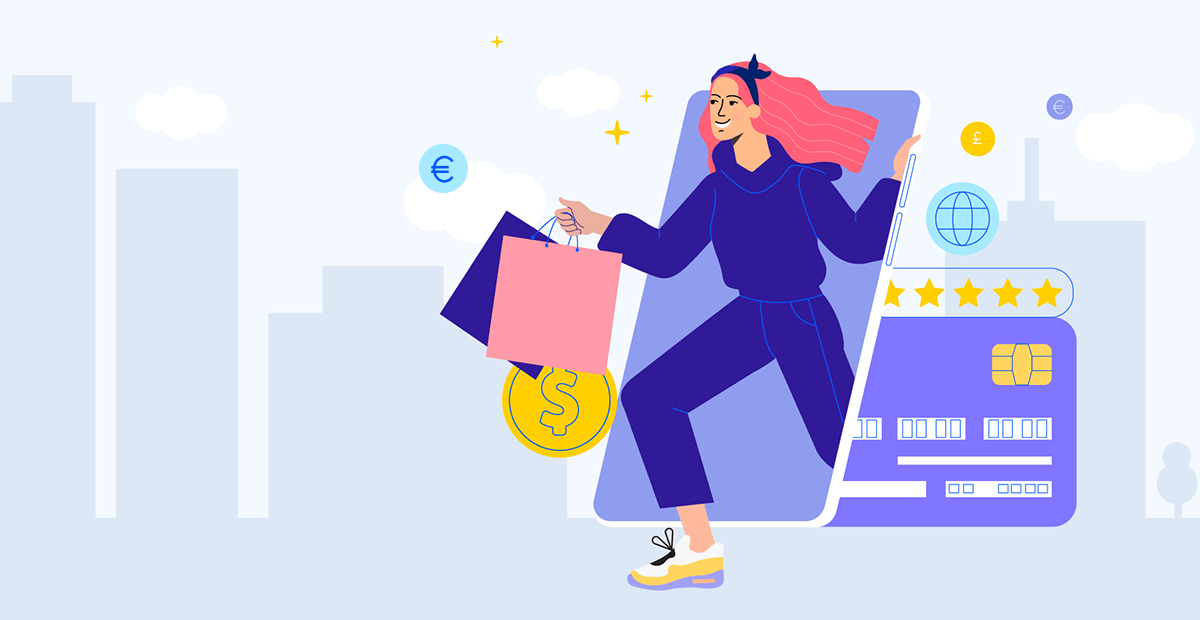
Electronic commerce (e-commerce) refers to online purchases and sales of goods and services by businesses and consumers. E-commerce can be done on computers, tablets, cell phones, and other smart devices and works in a range of market areas. E-commerce transactions make practically any good or service available, including books, music, airline tickets, food, and financial services such as stock trading and online banking, easily accessible.
Using an e-commerce app offers multiple benefits that enhance the overall shopping experience. By utilizing the app, you can shop anytime and from anywhere of your comfort zone. It provides you a user-friendly interface, easy navigation and make it simpler for you to explore variety of products and services. advance features like sending you alerts of discounts, quarterly sales, loyalty programs, new products, payment history, and more.
What are the Advantages of E-commerce for Customers?
In recent years, with the latest technology used e-commerce app offers you wide range of benefits that change your view of shopping online and make a good experience. This offers you exceptional conveniences and easy accessibility of product and services, which allow customer to search and purchase online in their comfort zone and from any location they want. This app grows your business reach and customer base by marketing, being any geographical location. Also, they boost up user experience with built in interface and seamless navigation. It also gives you to personalization and customization options for specific recommendation and search based on individual needs, encouraging to build strong customer engagement. Last but not least this app leads to cost saving and increase efficiency for both businesses and customers by making smooth and easy online payment and reduce other expenses.
5 E-commerce Trends to Watch for in 2023
Marketing Automation
With marketing automation, it’s simple to automate email campaigns, plan social media posts, retarget customers, and a little modification to your messaging with just a few clicks. It’s like having a real magical tool at your fingertips, turning your marketing strategy from good to stunning.
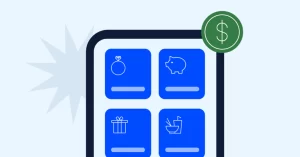
Artificial Intelligence (AI)
AI can gather information about consumer shopping habits. Customers’ shopping habits, preferences when looking for goods or services, and the time of purchase can all be considered. This data can be used by brands to provide a customized purchasing experience. AI consulting can broaden your horizons in this area.
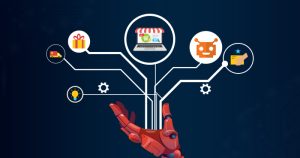
Augmented Reality for Product Visualization
In order to have an important effect on customers, an increasing number of businesses are adopting augmented reality into their advertising campaigns. Retailers and marketers all around the world are utilizing augmented reality (AR) concepts or shopping ideas like virtual humans or trying before you buy to boost sales.

Chatbots as Personal Assistants
Chatbots can now be used as assistants to have personalized conversations with customers. They can even run constantly, allowing you to guarantee customer interaction even when you are not in the office. They are not meant to completely take the position of human employees, but rather to start conversations, respond to common questions, and deal with smaller issues quickly.

Blockchain – The New Shift
Blockchain in e-commerce is one such technology that has received a lot of attention and has been widely used. By securing sensitive data with unbreakable techniques, it guarantees safe transactions in e-commerce. Additionally, it offers companies a trustworthy means of safeguarding and securely exchanging data.
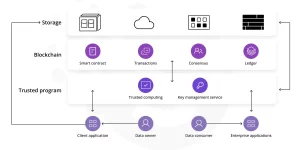
Few Tips for Developing Successful E-Commerce Apps
1. Make sure your UI/UX design is simple and intuitive
People will spend more time using your app if the user interface appears attractive and well-designed, which may eventually assist them make a decision to buy. Confusion will divert attention from the points of interest, increasing the possibility that the customer will give up on their search for products. concentrate on developing a user-friendly, organized, and customer-oriented application.
2. Logging in and signing up should be swift and seamless
When a new e-commerce program is installed, each user creates a new account. Naturally, you need certain information from your users in order to process their payments, verify their identity, and set up appropriate transaction and account security. If the sign-up process is excessively lengthy, customers may opt not to complete it and quit your app. So, while creating an e-commerce application, try to strike a balance between the security you provide and the difficulty of the registration procedure.
3. Include quality and descriptive images
It is critical to include a detailed description of your products, and it would be much better if you could add a photograph. Customers will be able to compare numerous products from the same category and swiftly determine whether they are what they are looking for. Your category management and product descriptions are essential. Customers will be able to compare numerous products from the same category and swiftly determine whether they are what they are looking for. Make certain that the images are of sufficient quality to effectively display all of the information while also being pleasing to the eye. Include photographs of the finished product from several angles if feasible.
4. Focus on security of personal data and transactions
People are willing to trust you with their bank account details and other data if they decide to utilize your mobile e-commerce app. Because of this, a hacker attack could target your application. You must stop any data breach from happening if you don’t want to permanently damage your reputation.
5. Add social media integration option
It is critical to include a detailed description of your products, and it would be much better if you could add a photograph. Customers will be able to compare numerous products from the same category and swiftly determine whether they are what they are looking for. Make certain that the images are of sufficient quality to effectively display all of the information while also being pleasing to the eye. Include photographs of the finished product from several angles if feasible. Also, you can use social media integration to complete the transaction and sign-up forms.
6. Simplify the checkout process
The final step in the purchasing process is checkout. As a lot of private information is entered to complete the transaction, it is also the stage that needs the greatest security attention. As a result, it takes a long time to verify the information and make sure it didn’t get stolen.
7. Many payment options as possible
There are numerous payment options available. The plethora of alternatives, from local to worldwide, credit cards to eWallets, may astound you. Still, if you want to accommodate as many clients as possible, you should attempt to integrate as many payment choices as you can into your app.
Conclusion:
The growth and impact of e-commerce apps in the modern market cannot be underestimated. Customers are reaping the benefits of convenience, variety, competitive pricing, personalization, and seamless delivery offered by these apps. We foresee the dominance of mobile commerce, developments in artificial intelligence and machine learning, the adoption of augmented reality, the emergence of voice commerce, and the focus on sustainability and ethical consumption as we look ahead to 2023. The way we buy is about to change even more as e-commerce applications make shopping simpler and more entertaining than ever. Join the e-commerce revolution now and welcome the future of retail!
- October 12, 2023

Many startup firms are unable to present the true value of their assets to potential investors. Inefficient supply chain system, verifying and transferring the company’s data from one source to another is a time-consuming and difficult task. Small companies having inadequate capital struggled to manage their trade financing. As a result, many corporations including startups and established businesses have begun exploring blockchain applications to digitize their transaction processes and transform their business models.
The marketing industry has experienced digital transformation over the past few decades. Technology has helped to modernize business trends by making digital payment technology more accessible to people. From creating decentralized transaction records to providing easy access to online payment methods, and investing in stocks, property, precious metals, or other market assets, Cryptocurrency and blockchain have empowered businesses to drive innovation in digital transactions. Furthermore, with the association with cryptocurrency and NFTs, blockchain technology has become an essential part of management solutions for global industries.
The alternative digital currencies comprising Bitcoin, Ethereum, and Dogecoin have emerged as established and popular cryptocurrencies today. Digital currency including Bitcoin is used as a digital form of cash to pay for everyday items including making larger purchases. Using blockchain, cryptocurrency can be sent anywhere without currency exchange. Moreover, money can be transferred without third-party assistance such as banks.
“The whole point of using a blockchain is to let people — in particular, people who don’t trust one another — share valuable data in a secure, tamperproof way.” — MIT Technology Review
Blockchain’s decentralized nature is gaining much attention these days. Large corporations are using blockchain-based digital currency to streamline their business model. It improves automating processes, reduces costs, and increases business efficiency.
The article delves deep into the concept of Blockchain technology. Readers will come to know how Blockchain works and the process of decentralization of transactions. The informative content will let individuals and organizations learn about digital ownership, and how Blockchain technology generates a safe and transparent record of ownership of digital assets. The next part of the article expounds the overview of NFTs and explore blockchain platform covering Ethereum, Binance, Smart Chain, and Flow. The last part of this article will help readers know how they can transfer their amount safely. Using this modern and open method of asset exchange further assists people in investing in assets and offers a secure and transparent record of ownership that cannot be altered.
The Wave of Innovation with Blockchain: How Blockchain Networks Ensure the Security of Data?

Getting into the Blockchain Process
Many businesses across the globe have integrated Blockchain technology to maintain a secure, decentralized transaction record of purchasing. Electronic currency is comprehensively accepted as the fastest alternate mode of payment to fiat currency. A decentralized payment system was introduced in 2008 by Satoshi Nakamoto. Blockchain functions as the public transaction ledger of the cryptocurrency Bitcoin and is used for payment processing, money transfers, and store transactions. Blockchain marked as the first digital currency is beneficial for businesses to store large transaction data in blocks. They are connected by a chain. As the quantity of transactions increases, the blockchain record and confirm the time of money transfer and also display the sequence of transactions. Having a strong database for recording transactions, Blockchain networks increase data sharing capacity by protecting data from unauthorized access. The shared ledger ensures data confidentiality as the Blockchain records the transaction details as soon as money is transferred.
The security of blockchain-enabled systems is based on numerous factors including network traffic, the size of each block of data, and the speed of the transaction process provide end-to-end encryption of data storage and privacy. Blockchain has successfully interchanged the conventional payment method, encouraging more people to use blockchain networks. It processes transactions rapidly and smoothly. With Blockchain, businesses can efficiently examine supply chains, identify loopholes within business logistics management, and improve logistics networks in real time.
App development services assist Blockchain users in knowing how the complex procedure works. The blockchain is a digital database, composed of encrypted blocks of data. The blocks are packed with updated recorded data that is synced with every node of the blockchain. Each block is chained together and operates on a distributed ledger. All transactions and data are shared between parties irrespective of geographical or other physical status.
Moreover, the ledgers involve access to the public or private keys. It signifies restricting access to unauthorized parties to keep hackers from interfering and changing information on the blockchain. Consequently, it helps carry out smooth and transparent transactions. The two keys help create a secure digital identity known as a digital signature. The digital authentication key is merged with a peer-to-peer network. Having a shared ledger, this network maintains a record of the transactions of numerous people. Blockchain users employ digital payment methods to ensure secure and quick transactions. Furthermore, using their digital signature allows them to verify their transaction details. Consequently, the confirmation of a secured transaction between the two network-connected parties leads to transparent and scalable transactions. The business that is looking for quick and convenient transactions, blockchain technology serve as an appropriate payment option. Block chains protect and secure your complex data, and store other types of information, such as product tracking and other data.
The Role of Blockchain in Digital Asset Ownership
Digital ownership comprises the freedom to use, sell, or change the digital asset according to the owner’s requirements. Blockchain development services have opened lucrative prospects for individuals and businesses to secure and decentralized digital ownership. The developer ensures the security of holding and controlling digital assets including art, music, video games, and financial data. People can send large amounts to any location smoothly without the support of banks or governmental organizations.
In a traditional payment system, people having insufficient money unable to purchase the entire asset such as real estate or a piece of art. However, blockchain has provided flexibility and smoothness in buying large assets. The ownership of digital assets follows a procedure. The assets are divided into digital tokens with blockchain-based systems. People can opt for fractional ownership of the asset. It implies dividing assets into a particular portion of the asset that can be either purchased or traded by the users. Therefore, ownership of assets takes place through a safe, and transparent digital method. Fractional ownership employing blockchain technology lets people know the consistency in transferring the ownership of transactions. Moreover, the users can easily do trading of the asset. Either they can buy, sell the tokens, or store their assets.
Having digital ownership of the assets provides a secure and decentralized ledger of transactions that easily helps in the transfer of Web3 digital assets. Moreover, the users have a solid and open method of asset exchange without requiring assistance from negotiators. Hence, a decentralized blockchain system provides a secure, clear, and lucid record of ownership that cannot be altered or deleted.
Overview of NFTs: Navigating into the World of NFTs
Non-fungible tokens (NFT) are regarded as cryptographic assets that are created on blockchain technology. The tokens have unique identification codes and meta-data that make them exceptional for the users. People can store, trade, and demonstrate their digital assets to a large audience. In 2020, NFTs scaled the market and revolutionized the concept of digital ownership. The global NFT market size is expected to hit 5093.3 million in 2022 to 2028. Therefore, it leads to the development of NFT-based marketplaces across the global crypto world. Now NFT is widespread in various fields including the digital art world, music sports, virtual real estate, collectibles, trading cards, and games and art. With the rise of NFT and crypto digital payment, large corporate firms are exploring ways to engage with the world of NFTs.
The NFT market development Services have generated an entirely new world of digital assets such as purchasing digital lands in the virtual worlds, access to metaverse games like avatars, and ownership of other digital products. NFTs involve a similar kind of programming used to generate cryptocurrency tokens. However, the procedure is different. Each NFT contains distinctive identification codes that are disparate from each other. Consequently, it makes it easy to transfer tokens between owners. NFTs denote real-world items including artwork, gaming assets, and real estate. But they lack physical form. NFT users tokenize these assets which allows them to do NFT trading easily.
How NFT marketplaces Works
If you desire to purchase, sell, and trade your NFT, you are required to follow easy steps. According to NFT experts, the users are required to open an account on a crypto platform to enter the NFT marketplace. The first step is to. A crypto exchange is an online platform that enables crypto users to buy or sell various kinds of crypto assets. Whether individuals aim to buy NFTs or sell them, they are required to research and explore the platforms that meet their criteria. Many users opt for the Ethereum blockchain, it has been vastly used by businesses for NFT trading. Ethereum, a decentralized ledger can monitor the ownership and transaction history of every NFT. Furthermore, the distinctive code and ID of the NFT ensure the security of the NFT and won’t allow illegal parties to create duplicate tokens.
Once consumers have chosen the platform, they can proceed toward opening the account. The next step follows creating a crypto wallet that provides access to digital assets. Let’s suppose, the users have selected the crypto wallet that is compatible with the Ethereum blockchain network. Consequently, they require an Ethereum wallet to buy or sell NFT tokens.
Before planning to buy or sell NFT tokens, buyers should pre-fund their wallets. For this purpose, they have to get involved with research to find out which cryptocurrency supports their crypto wallet.
Once the wallet is connected and financed, consumers can begin trading NFTs. NFT marketplace development company assists users in how to trade their NFTs in a marketplace. For instance, if a buyer purchases an NFT, they gain ownership of the asset. The selling of digital assets appears to be a complicated process. If the user is selling his artwork or a soundtrack, it is a prerequisite to upload the chosen digital asset onto the marketplace. Enter a fixed price or sell the NFT through an auction. The users should verify the asset. If it is approved by a large number of consumers, it is enlisted for sale.
Some NFT users desire to mint an NFT. It signifies creating an NFT. Consumers may consider using the Ethereum blockchain system to create NFTs. Moreover, IOS mobile app development has introduced various NFT apps that enable users to sign up for an NFT marketplace. Customers can click on the button located on the top right-hand corner of the NFT marketplace homepage. When they get connected to the digital wallet, they enter the wallet password to complete the NFT marketplace entrance process.
The Top Blockchains for NFT Development
1. Ethereum
Ethereum offers a decentralized ecosystem covering different financial and business organizations. Renowned NFT marketplaces comprising OpenSea, CryptoPunks, and the Bored Ape Yacht Club (BAYC have supported the Ethereum platform for NFT trading. A decentralized blockchain network allows users to carry out trades, earn interest on their investments, and store NFTs. Moreover, customers can play games and trade cryptocurrencies. The decentralized design of Ethereum effectively manages the system; it does not require any central body to control the system or facilitate the transaction process. Ethereum also ensures the privacy of transactions and data. Businesses can join private partnerships to improve business prospects. Private information is encoded and shared with trustworthy clients. Furthermore, using Ethereum helps in the tokenization of digital assets. Organizations can fractionalize assets, expand their product line, and open new incentive models.
Businesses may encounter risks with Ethereum in investing in cryptocurrencies. The price might change which causes a great to investors. The other flaws relate to the security issues. As Ethereum is a digital ledger, technical errors, and malfunctions might take place, therefore, there is a danger of hacking personal data or transaction details.
2. Solana
Another widely used blockchain app by NFT e-commerce companies is Solana. The significant features comprising PoH (Proof of History) and strong mechanisms offer a high transaction rate per second to improve the digital ecosystem. The app is supported by stunning architectural design that ensures affordability and outstanding quality outputs. Solana offers a solid marketplace to collectors, buyers, and creators to carry out quick minting of NFTs. Additionally, it delivers low transaction costs, high speed, scalability, and interoperability. Therefore, it is regarded as the NFT blockchain best-rated app.
3. Tezos
The popularity of this app is growing among blockchain users. The artists use the app for minting their digital assets including digital art, painting, and music. Tezos is an open-source blockchain protocol driven by a global community of developers and researchers. They participate in the NFT marketplace and get rewards for their contributions. Moreover, the flexible and strong network brought huge coin offerings from the crypto space. It has earned earn $232 million, making it one of the largest ICOs of all time. Like other blockchain apps, it enables blockchain developers to create smart contracts and develop dApps.
The main pitfall of using Tezos is a delay in issuing tokens that causes many users to miss their chance to get rewards. The other disadvantage that investors find is an undeveloped network of the app as it fails to predict transaction fees and speed of transactions.
4. Flow
A recognized proof-of-stake blockchain and a decentralized channel supports dApps including NFTs trading, NFT collectibles, and crypto games. NFT developers have come up with high-potential applications that can be easily accessed by many NFT users. With a shorter lead time, Flow helps businesses reduce inventory costs and provides more space for storing goods. The main objective of flow production is to increase productivity and help improve high-performance ecosystems of games and other applications. The drawback of Flow is high set-up costs. The machines and tools employed to create the app are too expensive and also involve high maintenance costs.
5. Cardano
A robust and multipurpose blockchain platform executes smart contracts and also generates numerous decentralized apps for NFT users. The blockchain-based platform is ideal for investors as it creates a safe, and transparent payment system. The app delivers quick speed, security, and scalability. The strong mechanism of this blockchain platform includes two significant systems, the Cardano Computation Layer (CCL) and Cardano Settlement Layer (CSL) that help build decentralized applications.
Conclusion
Blockchain technologies are growing at an exceptional rate, empowering digital payment systems to store and transfer large data efficiently. From a security perspective, blockchain is considered a digital ledger of transactions that have unique characteristics. Having a robust security system, the Blockchain network employs cryptographic techniques that secure data. The decentralized nature of blockchain ensures the security and privacy of data, making it tremendously difficult for unauthorized parties to either view or alter the information stored in the chain. Using Blockchain, businesses trust the technology to facilitate and verify transactions and they don’t require third-party services to view the data for privacy and transparency. Additionally, blockchain systems effectively streamline complex processes by automating tasks, saving users time, and effort. Moreover, Block chain improves supply chain management and leads to smoother, safer, and faster transactions.
- October 9, 2023
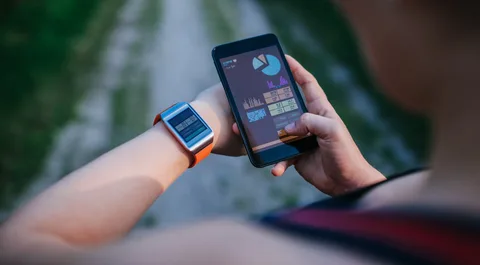
Over the past few years as technology has been upgraded, the ways in which we interact with it has become increasingly streamlined. We can now stay connected to our digital lives wherever we are or we go due to wearable technology, which has completely changed how we use and interact with technology. Users are able to access a wide range of features with ease and have a more personal experience matched to their needs by integrating wearable technology into daily life.
Wearable technology refers to an electronic device that you can wear on your body such as apple watch, air pods, smart clothing, AR & VR headsets and smart ring. These wearable devices are usually designed to track data or provide convenient functionality through installed technology.
What does UX for wearables mean?
Most of the wearable devices are being screenless, UX design for wearable is immediately ignored. It’s necessary to keep in mind that each wearable device needs to be connected to at least with another device for it to work properly. For instance, the data that is tracked on a screenless smart ring will need to be shared with a smartphone at some stage. In this scenario, the wearable UX design will focus on the steps to initiate the connection, the steps to transfer the data, and the design of the mobile app itself.
The quantity of trackable data increases along with the potential interactions between wearable technology and mobile applications. In consideration of the fact that most interactions happen across many different devices, wearable UX plays an essential role in the design of any product in this context.
Importance of User Experience Design in Wearable Mobile Apps
The effectiveness of wearable mobile apps is highly dependent on the User Experience (UX) design process. The importance of designing a friendly and smooth user experience increases due to the restricted screen size and various form factors of wearable technology. Users can simply explore the app, acquire the data they need, and utilize the features because of a well-designed UX. Reliability and quick interactions are essential for wearables because they are frequently utilized in mobile settings. A thoughtful UX design offers specific and context-aware experiences by taking users’ requirements and behaviors into consideration. Developers can improve the functioning of the app and boost user happiness by focusing on human-centric design concepts, such as clear symbols, easy actions and an effective data layout.
User-Centered Design Principles for Wearable Mobile App
It is a approach that meets end users expectations, decision and overall experience throughout the mobile app development process. User is the decision maker, in order to build goods and services which is easy to use, feasible and attractive. This involve in-depth of user research to understand the needs, preferences and problem areas faced by consumers.
Design Thinking Process for Wearable Mobile Apps
Once you gathered all preferences, needs pin points of users, then you start brainstorming the ideas to come up with multiple challenges and solutions. Once designer built the draft to visualized and test the idea, to get the feedback from stakeholders and users’ observation to conclude to final design of the app.
Designing for Different Wearable Devices
A smartwatch is a small screen wristwatch with extra features that are linked to a user’s smartphone. It also has a touchscreen. A smartwatch usually comes with an operating system and can run Apps, unlike normal wristwatches. It has multiple features such as getting text/call notifications, track health, call someone and more.
Fitness Trackers
This can help in constantly tracking the heart rate while keeping track of how many steps the user takes each day. Moreover, the devices can accurately calculate and display information on the user’s calorie burn and exercise, which has a major impact on fitness apps that are used to deliver health information.
Augmented Reality Glasses
Augmented reality glasses allow users to interact with virtual and real word in real time with the help of advanced camera and sensors technology in it. It consists of parts that combine to produce the visual impact of the things being added to the real environment.
Virtual Reality Headsets
Virtual reality headset provides you an amazing real word experience, it also gives you clear display and controls to navigate through menu. Users are able to navigate properly in virtual environment because of properly organized user interface.
Best Practices in User Experience Design for Wearable Mobile Apps
Clear interface:
Keep the UI clear and user-friendly while focusing on the user’s situation.Think about investing in a decent logo creator or logo maker and make a logo design that is eye-catching and suits your app design. And while the latter is important, you should also ensure there is enough space for all of your content. Ensure there is enough space for all of your content.
Glimpse data:
Making sure that users can have a quick look at their fitness data on their smartwatch.
Background notification:
It also gives you a notification once you have done extra steps in your activity.
Screen specification:
The kind of data that you can show on a screen and how much area there is for user interface elements depending on the size and resolution of the screen. Make sure all of your buttons and icons fit inside the circle or square of the screen without any gaps.
Layout:
If there isn’t enough space on the screen for everything you need to show at the same time, including images and text, consumers may find it difficult to read everything they need while using their watch.
Navigation App for Augmented Reality Glasses
Provide accurate instruction: The AR objects, settings, and alerts that direct the user through the AR experience must be clear and simple to the user. This can be achieved by using bright colors along with short, useful instructions.
AR Feature Self-Sufficient: the design of interactions for augmented reality (AR) needs to be self-sufficient; the user shouldn’t need to end the AR experience in order to learn more about an object or to make small changes such as adjusting the color or other similar features.
Virtual Reality Gaming App for Headsets
Text readability:
All of your extremely neat UI elements will appear blurred depending on the display’s resolution. Because there will be a lot of interference on straight lines and the text will be difficult to read. So, avoid big text blocks.
Brightness change:
The change from a dark environment to a bright scene may make the user uncomfortable as they get used to the higher level of brightness because of how close the screen is to their eyes.
Button placement:
If many smaller fuse buttons are placed close to one another, the user could accidentally click on the wrong one. Closely positioned, smaller buttons need to require a direct click to activate.
Wrap Up
Users of smart devices often bring creativity and uncertainty with them, so designers must be prepared to achieve usability. I’m hoping that these methods will give your consumers the ability to use wearables easily and effectively.
- October 8, 2023

Empower Your App’s Success With Our Comprehensive Guide
Having a fully-functional mobile app is an excellent contribution to your business. But, revealing it rightly to the audience is the key. You have crossed many steps but the crucial one is still awaiting.
Now is the time to tackle the hard part- enabling people to use your app. With the competitively evolving digital era, getting the attention from the audience has been difficult with over 2 millions apps available in the app store. Don’t worry; we’ve got you covered.
The Importance of Marketing for Mobile Apps
An effective marketing campaign will spread the word about your new app, attract users, drive downloads, and ultimately impact your ranking in the app stores. Marketing plays a phenomenal role in the digital world to capture the attention of your contribution to the field. To make sure your app is known, hiring a mobile app developer and marketing are the key.
- Use social media to spread the word about your new app and offer promotions to build buzz.
- Choose effective keywords and a compelling app description to rank higher in searches.
- Pay attention to user reviews and make improvements to address concerns.
- Keep an eye on changes in platforms, devices, and user behaviors.
The Fundamentals of Mobile App Marketing
To successfully market your app, you must master the mobile engagement loop. This loop refers to the cycle of:
- Acquiring new users
- Engaging and re-engaging users
- Analyzing user behavior and optimizing the experience
The key to successfully marketing your mobile app is understanding the typical stages and planning your approach. The significant steps usually include:
- Research your target audience.
- Develop a marketing plan that incorporates your research findings.
- Build a website to help establish your brand and be a central hub for all your marketing efforts.
- Creating content like blog posts, videos, and social media posts to spread the word about your app.
- Optimizing search engines and app stores to increase visibility.
- Collaborating with influencers who can help promote your app to their followers.
- Driving installs through paid advertising on social media, search engines, and app stores.
- Analyzing key metrics to see how users engage with your app and make improvements.
Identifying Your Target Audience
You need to identify your target audience to market your mobile app successfully. This means researching and defining who your ideal app users are. The best way to do this is by creating user personas. If you are unsure on how to do this properly you can always outsource to an agency.
A persona is a representation of your target customer that includes details like:
- Demographics (age, income, location)
- Behaviors and interests
- Goals and challenges
- How they’re likely to use your app
Defining your audience is an ongoing process that requires continually connecting with users and evaluating how people engage with your app. However, investing the time upfront to identify your target audience will set you up for success and empower your marketing efforts.
Thorough Market Research
- You must understand your target customers and competition to market your mobile app successfully. Conducting in-depth market research will provide invaluable insights to guide your marketing strategy.
- Do primary research through surveys, focus groups, and interviews. Ask open ended questions examples to discover what people want and need. See how they currently solve problems your app could help with.
- Also, do secondary research, analyzing reports and studies on your target audience and industry. Look at trends in the app stores to find gaps your app could fill.
- The more you understand your customers and competitors, the more empowered you’ll be to market your app successfully. The comprehensive market research gives you a competitive advantage by revealing insights your rivals may miss.
Pre-Launch App Marketing Strategy
- A solid pre-launch marketing strategy will build excitement and set the stage for your app’s success.
- Start planning at least 6-8 weeks before launch to generate buzz and get people counting down the days until your app hits the market.
1. Build your foundation
- Start building your email list and social media following early.
- Offer a signup on your website to collect emails, run a giveaway or contest to increase signups, and promote your accounts on all major platforms.
- Post regular updates, behind-the-scenes info, and teasers to keep people engaged.
- Setting an Early Timeline
When you plan to launch your app, work backward to set critical milestones. Allow at least 6-12 weeks for pre-launch marketing. The more time you give yourself, the more you can build anticipation and buzz.
2. Conducting Market Analysis
Learn who your target users are, their needs, and how your app can meet them. Analyze your competitors to see how you can differentiate yourself. This research will shape how you position and message your app.
3. Target Audience and Competitors
You must define and understand your target audience to market your mobile app development company successfully. Who will be most interested in your app? Are there any direct competitors you need to be aware of?
4. Creating an Engaging Landing Page
Design an eye-catching landing page to capture interest and excite people about your new app. Include captivating visuals, a short video demo, and clear call-to-action buttons.
5. Leveraging Social Media Platforms
Promote your app on platforms where your target users spend time, like Facebook, Instagram, and Twitter. Add to the hype by posting updates and behind-the-scenes photos and engage with your followers. Run social media contests and giveaways to increase the buzz.
6. Harnessing the Power of Email Marketing
Build an email list of interested users and send regular updates about your app’s progress. Offer beta access or discount codes to your email subscribers first. Personalized, targeted emails have high open and click-through rates, so get to know your users and tailor content to their needs.
The Stages of Mobile App Marketing Strategy
1. The Awareness Stage
Once your app is built, it’s time to spread the word. Your audience needs to know about your app to make sure they use it well. Setting a strategic launch date and working backward to plan your promotional activities is essential. Initially, build excitement by offering previews, sneak peeks, and beta testing opportunities.
The website is your digital home. Create a simple website or landing page to build your email list and social following. Build interest by offering a contest or giveaway. Engage your future users by asking for input or running a poll on features.
To let people know about your app, social media is your way to aware the audience on broader terms. Whether it’s connecting with influencers in your niche and offering them access to your app for an honest review to posting your best features, you can enable people to become likely interested in your product.
With connecting rightly with the target audience on platforms like Tiktok, Facebook, Instagram, and Twitter, you can engage with people. It is easy to post updates, behind-the-scenes info, and teasers to invite people to delve further. From giveaways to contests, social media provides an array of engagement options. Social media is a crucial way to spread the word about your app to potential users.
2. The Acquisition Stage
Once your app is live, utilize paid advertising to increase downloads and get more users. With the right acquisition strategy, you’ll gain many new users and see your app’s success proliferate.
Pay-per-click ads on social media or the App Store can drive traffic to your app’s page. Be strategic with your ad targeting to reach your target audience and test different creatives and copy to optimize your ad performance.
Choose engaging app screenshots, a well-written description, and smart keywords that people search for. High rankings mean more people will discover your app organically. Moreover, always remember to monitor your app’s keywords and adjust as needed to climb the charts.
In addition, Videos are highly effective for demonstrating an app’s capabilities and user experience. Create short video walkthroughs highlighting your app’s key features and functionality. Post them on your app’s website, social media channels, and video platforms like YouTube.
3. The Retention Stage
Once your app is live and users have had a chance to download it, the real work begins. This is the retention stage, where you must keep people returning and using your app. It will be unsuccessful if people download your app but never open it again.
The user experience (UX) is key. Make your app intuitive, easy to navigate, and simple to use. Offer helpful tutorials or walkthroughs for new users. Provide value right away so people see the benefit of your app quickly. A great UX will keep people coming back.
Push notifications are a must, but don’t overdo it and annoy your users. Send relevant alerts about the app’s new content, features, or activity. Make notifications personalized based on user preferences or past behavior in the app.
Give your users a reason to come back, like offering credits, coupons, or special unlocks after a certain number of sessions. You can highlight new features, content, or activities to encourage repeat visits.
With the right retention strategy, you’ll build a dedicated base of loyal users who keep coming back to your app. Focus on crafting a stellar UX, sending engaging push alerts, offering incentives, making improvements based on analytics, and keeping your app fresh. Keep your users happy, and they’ll stick with you!
4. Paid Promotion Strategies
Once you’ve built your mobile app, it’s time to get it in front of users. Paid advertising is one of the most effective ways to gain significant exposure and boost downloads. Here are some of the top paid promotion strategies to consider:
5. Social Media Ads
Social media is home to millions of users. Making the most of it is now in your hands to ensure your apps never go unnoticed. Promoting your app on platforms like Tiktok, Facebook, Instagram, and Twitter is necessary. These channels have massive reach and targeting options to connect you with your ideal users. You can run ads to increase brand awareness, drive traffic to your app store listing, and prompt downloads.
6. Google Universal App Campaigns
Google UACs make showing your app to potential users across Google Search, the Google Play Store, YouTube, and the Google Display Network easy. You only have to set up one campaign to reach people on their favorite Google properties. UACs optimize automatically to give you the best results within your budget. It is your time to shine bright and let your app reach every corner.
7. Influencer Marketing
Partnering with influencers in your niche is an authentic way to spread the word about your new app. Reach out to influencers with an engaged following and ask them to promote your app through social posts, YouTube videos, podcast mentions, and more. In exchange, you can offer them compensation, free access to your app, or a customized promotional code for their followers.
8. Native Advertising
Native ads blend in with the content around them, so they don’t feel like disruptive ads to users. You can run native app install ads on platforms like Outbrain, Taboola, and Revcontent to get your app in front of audiences reading content related to your app’s category. The ads appear as suggested content at the end of articles, drawing clicks from readers interested in your topic.
Conclusion
Finally, you are done with the easy guide to unlock your keys to marketing your mobile app. We pave your path to success and increase user engagement with marketing that unravels the marvels. While it may seem to be too much to deal with, focusing on each one will serve the right purpose.
Don’t get overwhelmed by trying to do everything at once. Pick the channels and tactics you think resonate most with your target users and double down on those. Marketing is a continuous cycle and getting it done once will not make any difference. Keep improving on each step to let your hustle be your voice of success.
If you put in the effort to create a terrific app and are committed to getting it in front of the appropriate people, you’ll be well on your way to mobile app marketing success. Now, get out there and make it happen! Your app is waiting.




